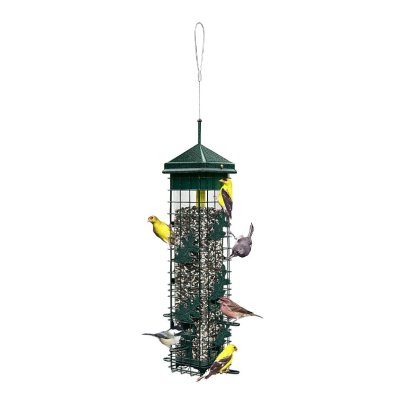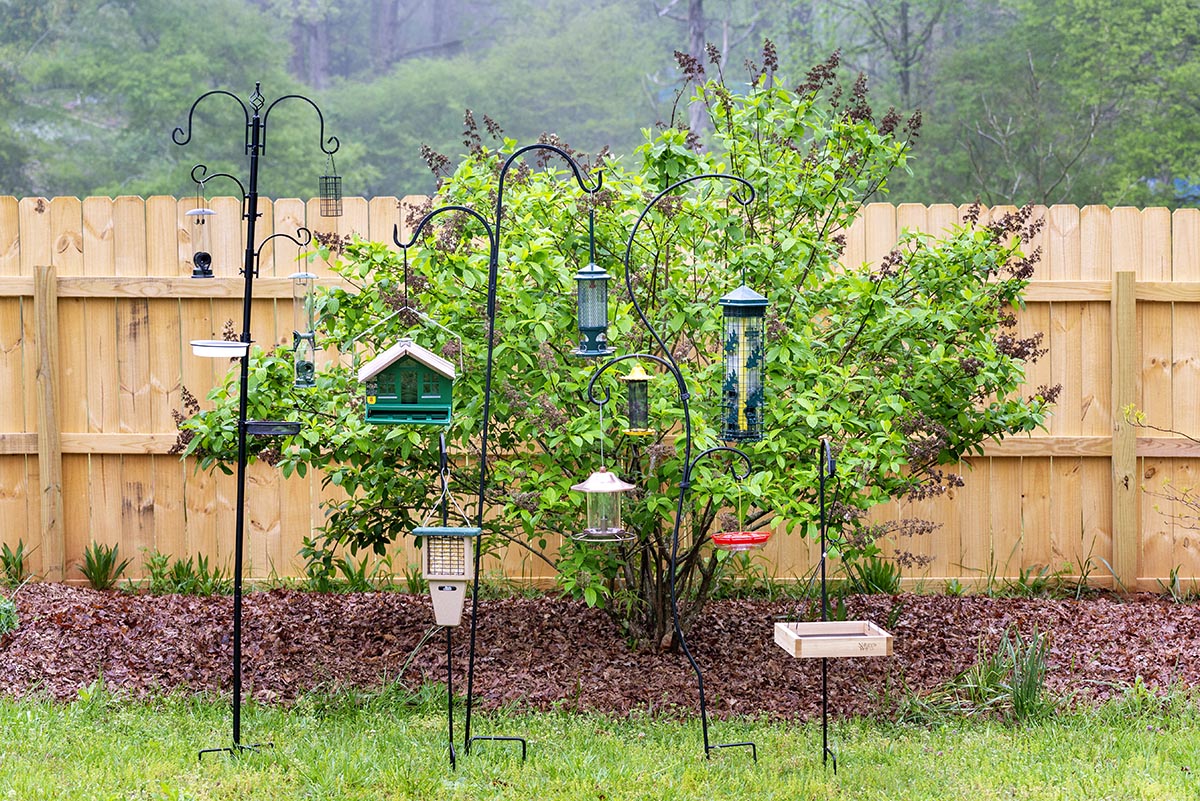
We may earn revenue from the products available on this page and participate in affiliate programs. Learn More ›
It’s only natural for people to watch birds with fascination, affection, and a touch of envy at their ability to fly freely. The practice of setting up feeding stations to attract diverse species of birds dates back hundreds of years. We’ve tested some of the best bird feeders on the market to help you choose the right one for your feathery friends.
Today, the best bird feeders make it easy to offer birdseed and other food substances for specific species while deterring the intrusion of squirrels and other critters. Bird feeders are designed for suspension from hooks or tree branches, mounting on vertical poles, attaching to windows, or placing on flat ground surfaces. The many options meet the needs of both birds and bird lovers.
Keep reading to learn what you need to know before selecting a new bird feeder for your yard, and check out some of the best bird feeders on the market below.
- BEST OVERALL: Brome Squirrel Solution200 Squirrel-proof Bird Feeder
- BEST BANG FOR THE BUCK: Perky-Pet Copper Panorama Hanging Bird Feeder
- BEST TUBE FEEDER: Gray Bunny 6-Port Bird Feeder – Premium Grade Metal
- BEST PLATFORM FEEDER: Nature’s Way Cedar Platform Tray Bird Feeder
- BEST SQUIRREL-PROOF: Brome Squirrel Buster Standard Squirrel-proof Feeder
- BEST THISTLE FEEDER: More Birds 38194 SeedFeed Stokes Select Finch Feeder
- BEST HOPPER FEEDER: Perky-Pet 8lb Squirrel-Be-Gone II Feeder Home
- BEST SUET FEEDER: Birds Choice SNTP Recycled Single Cake Suet Feeder
- BEST NECTAR FEEDER: Aspects HummZinger HighView 12 Oz Hummingbird Feeder
- BEST BIRD FEEDING STATION: Best Choice Products 4-Hook Bird Feeding Station
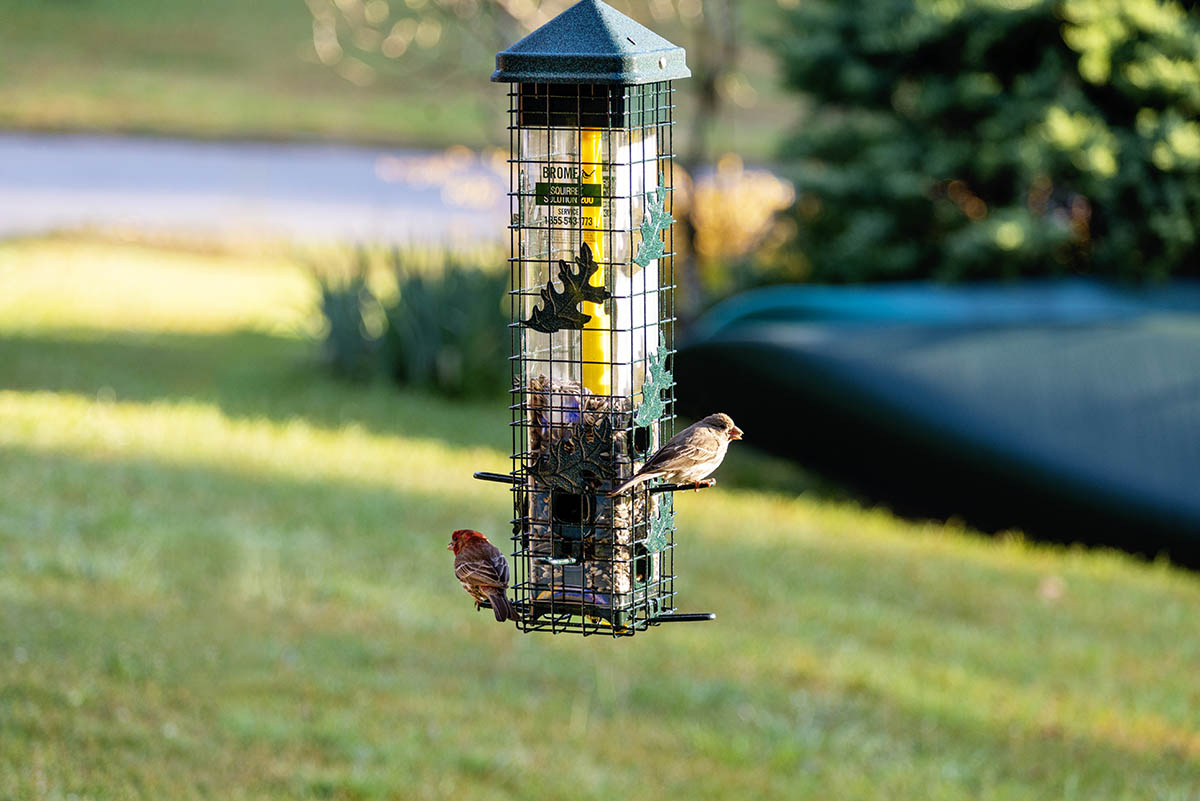
Types of Bird Feeders
Many bird lovers position multiple types of bird feeders throughout their outdoor spaces. They can fill these feeders with a variety of seeds and bird-food items to attract an array of species.
Ahead, learn more about the different types of bird feeders along with tips on how to use them to support a diverse population of feathered friends.
Ground
Most birds will eat from the ground, and some species are especially attracted to food placed at ground level. It’s their preferred method of acquiring nutrition. Ground-feeding species include doves, pigeons, sparrows, cardinals, grouse, quail, juncos, starlings, buntings, and more. To attract these species, bird lovers may place inviting foods in low-to-the-ground feeding trays.
Ground-feeding trays on short legs offer a useful setup option to attract birds, and many bird lovers offer a variety of foods in separate trays placed around the yard. Food items that attract various species include black oil sunflower seeds, thistle seeds, millet, cracked corn, peanuts, and dried fruit.
Place only a day’s worth of feed in trays to avoid a buildup of treats that will attract raccoons, mice, rats, and other unwelcome creatures. Rake or sweep the ground to remove spilled seed and shells on a regular basis. Place the ground-feeding trays under the roof of a covered patio or gazebo to protect the seed from rain.
Tube
Tube bird feeders are popular with avian enthusiasts, and many bird species are known to eat heartily from them. A tube bird feeder features an elongated cylinder to hold the birdseed along with small openings and perches positioned along its length where birds can alight and access the seed. Many squirrel-resistant bird feeders exhibit a tube design, and these feeders offer the additional advantage of keeping the birdseed dry.
Tube feeders are designed to hang from hooks or tree branches. In many feeders, the tubes are constructed from heavy-duty transparent plastic so people can view the seed level at all times and know when to refill the feeder. The bases and lids may be made of plastic or metal, and they are removable for cleaning and refilling the feeders.
Depending on the size of the cylinders and feeding ports, bird lovers can offer a variety of seed sizes in tube feeders, attracting an array of bird species. In general, tube feeders tend to attract small birds such as sparrows, chickadees, titmice, finches, and grosbeaks.
Hopper
Depending on its size, a hopper feeder can hold a large amount of birdseed. The principle of hopper design is a tapered container that allows its contents to empty out into a tray at the bottom. As birds eat the seed from the feeding tray, the remaining seed stored in the hopper falls down into the tray so the birds can receive fresh seed on demand.
Hopper bird feeders might hang from hooks or tree branches, or they may be mounted on poles. Many types exhibit designs that resemble tiny houses, including pitched roofs that keep the seed dry. Those with clear plastic sides enable bird lovers to keep an eye on the seed level.
Hopper feeders are more difficult to clean than tray feeders, but many feature lift-off roofs to make the task easier. This is convenient for the user to load a hopper feeder with a large quantity of seed that will last for days or weeks. But, if the seed becomes damp and moldy, it can be unhealthy for the birds.
Suet
The term suet refers to animal fat, and it’s a tasty cold-weather treat for many bird species, including chickadees, nuthatches, titmice, wrens, jays, starlings, and woodpeckers. While raw suet goes rancid in above-freezing temperatures, rendered suet lasts longer. Still, suet should be offered only in cold weather, since suet’s melting fat can coat bird feathers, causing danger to the birds.
Suet bird feeders usually feature cages or baskets made from wire or plastic mesh. Bird lovers place suet cakes into these containers, and the birds access the food through openings in the mesh.
Suet cakes are made from a mixture of suet (or a substitute such as peanut butter) and other ingredients. Cornmeal, birdseed, peanuts, and fruits are frequently included in suet cakes. Users may avoid spoilage by keeping suet cakes refrigerated until they are placed outdoors for birds in cold weather.
Thistle Seed
Nyjer seed (also known as thistle seed) is a favorite for many bird species, including goldfinches, purple finches, juncos, quail, mourning doves, sparrows, and more. Although pure thistle seed is expensive, it is often mixed with other seeds and packaged for feeding birds.
Thistle bird feeders feature wire mesh, tube-shaped construction or tiny feeding portals where the birds access the small thistle seed. Small birds cling to the mesh and pull the seed through its openings, or they sit on perches to eat from the small, thistle-sized portals.
Alternatively, bird lovers can offer thistle seed in hanging mesh bags called thistle socks. Finches and other small birds cling to the mesh and feed on the thistle as they pull the seeds through openings in the mesh fabric.
Nectar
Many backyard birders enjoy watching hummingbirds, the tiniest members of the avian community. With their bright shiny colors and swift darting movements, hummingbirds are fascinating to watch.
Enthusiasts attract hummingbirds by offering nectar in brightly colored feeders made from glass or plastic. The liquid food is poured into the bottle-shaped feeder, and a base with perches provides access for the hummingbirds.
While commercially made nectars are available, many birders make their own mixtures of one part sugar to four parts water. Experts recommend that red dye should not be added to hummingbird nectar and to refrigerate premixed nectar until use. To keep them clean, nectar feeders should be emptied, washed, and refilled every other day or at least twice each week.
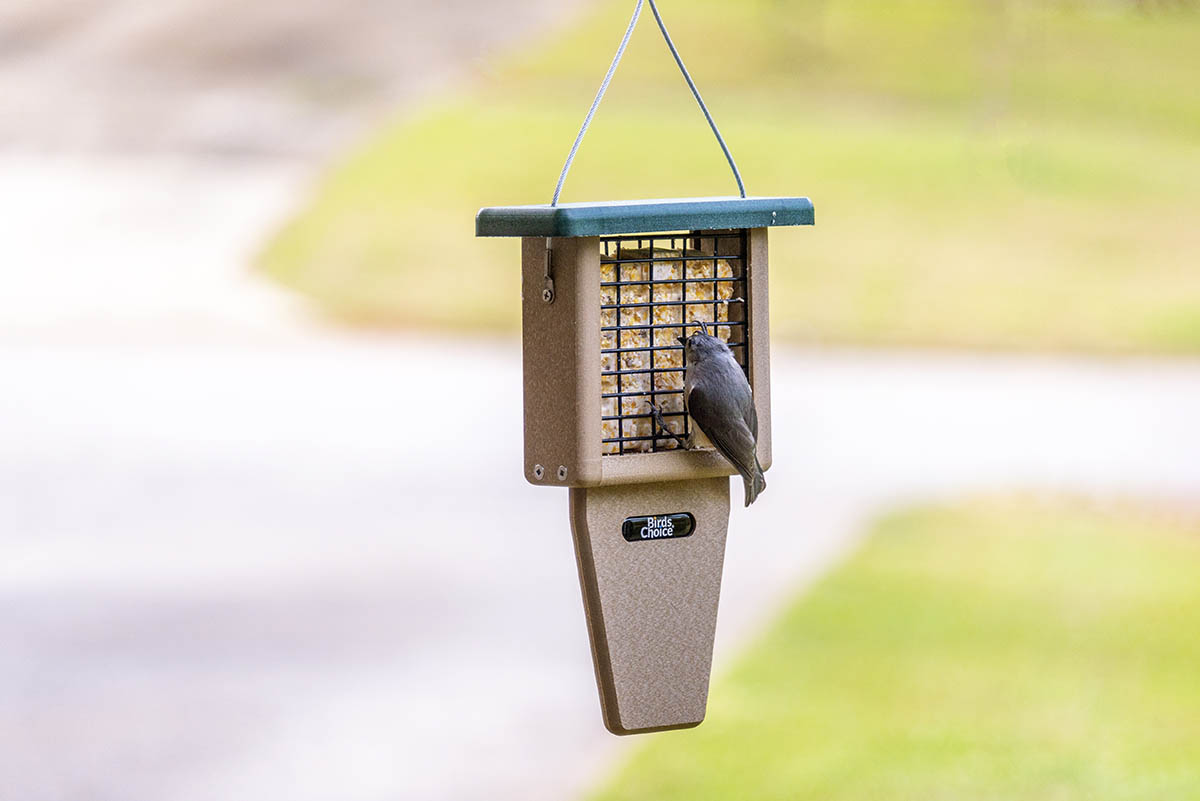
What to Consider When Choosing the Best Bird Feeders
Depending on location and a desire to attract specific bird species, shoppers may consider feeders with particular designs. Various types of bird feeders help provide a diverse selection of seeds and other suitable food items. Of additional importance are durable and high-quality materials that are safe for birds and resistant to other critters to meet the high standards of bird lovers.
Material
Bird feeders are generally constructed from metal, plastic, wood, or combinations of these materials. Shoppers can look for materials that are sturdy, weather-resistant, rustproof, waterproof, and squirrel-resistant.
Heavy-duty polycarbonate plastic provides durability and see-through transparency for many bird feeders. However, squirrels are known to chew through plastic whenever they can. Metal construction is more squirrel resistant, but metal is susceptible to rust.
Attractive wooden bird feeders feature designs that resemble small houses or gazebos. Natural cedar is a durable wood that repels insects, and birds are comfortable with the material. The downside of wooden bird feeders is that squirrels might chew on the wood.
Food
Various types of seeds form the basic diet for backyard birds. Sunflower and safflower seeds are favorites of many species, while tiny nyjer or thistle seeds attract finches, buntings, and other small birds. Millet, flax, and cracked corn are favorites of ground-feeding birds, while peanuts provide a delectable treat for woodpeckers, titmice, and jays.
Consider the species of birds that are native to a particular region, and offer food to attract the desirable feathered friends. Be sure to keep seeds and other bird foods dry; damp food quickly becomes a breeding ground for bacteria and mold that can be harmful to birds. Clean up spilled seeds and empty shells around a bird feeder to deter rodents and other unwelcome critters who may come to dine.
Overall Design
Avid birders frequently accumulate a collection of bird feeders in various designs, placing them throughout an outdoor space to attract species of diverse sizes and eating preferences. Typically, feeders can hang from hooks or tree branches or mount on poles. Window feeders that attach to exterior panes via suction cups create entertaining venues for bird watching from the comfort of a favorite armchair.
Effective bird feeders are easy to clean and refill, and they provide a roof or other covering along with drainage to keep the birdseed dry. Although a tray bird feeder can accommodate ground-feeding birds, it should be changed daily to prevent spoilage as well as the presence of unwelcome nocturnal visitors.
In many locations, an active squirrel population presents a challenge for avian enthusiasts. Hanging squirrel-resistant bird feeders with auto-closing mechanisms prevents squirrels from accessing the birds’ food. Additionally, feeders mounted atop poles with cone-shaped baffles may deter squirrels from climbing up to feast on the birdseed.
Our Top Picks
With a plethora of viable bird feeder options on the market, bird lovers may end up spending a lot of time searching for the best bird feeders to suit their needs. To help with the selection process, the following are some of the best recommendations for feeders that we’ve tested in our own yards in an array of styles and sizes available at various price points.
Best Overall
Brome Squirrel Solution200 Squirrel-proof Bird Feeder
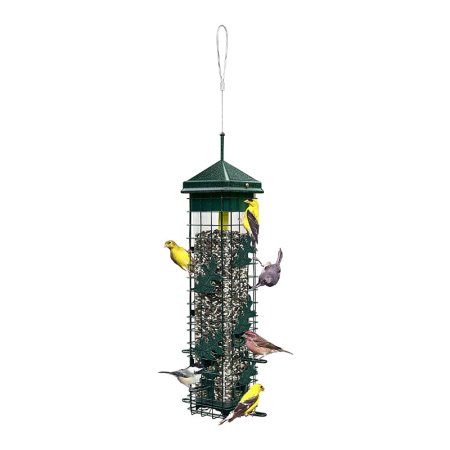
Pros
Cons
Product Specs
- Type: Tube
- Capacity: 3.4 pounds
- Squirrel-proof: Yes
Birds have their particular preferences on how they like to feed. Thankfully, Brome’s Squirrel Solution200 feeder features four perches and an outer wire cage to satisfy clinging and perching feeders. The feeder holds up to 3.4 pounds of seed and comes with a handy seed funnel that makes filling the feeder quick and easy.
This tube-style feeder is also squirrel proof. The openings in the cover align with the feeding ports, providing birds easy access to the food. However, when a squirrel climbs onto the feeder, its weight automatically forces the cover down, closing access to the ports without harming the animal.
This feeder performed well in testing. It successfully foiled squirrels over and over again. The size and design is perfect for small bird species such as house finches and chickadees. However, we noticed that larger birds seem reluctant to feed on it. Nonetheless, it’s an excellent durable feeder that will hold up for years.
Get the Brome Solution200 bird feeder on Amazon or Lowe’s.
Best Bang For the Buck
Perky-Pet Copper Panorama Hanging Bird Feeder
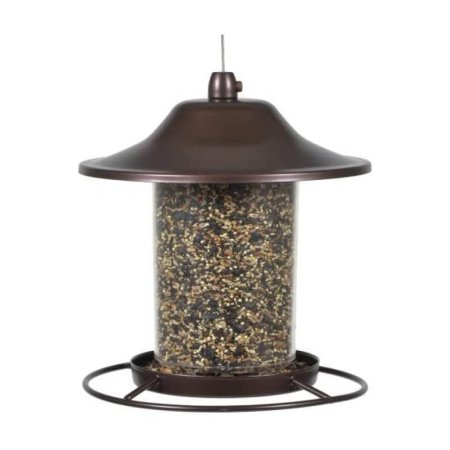
Pros
Cons
Product Specs
- Type: Hopper
- Capacity: 2 pounds
- Squirrel-proof: No
Enjoy watching the birds as they sit on the perches encircling this hopper-style bird feeder from Perky-Pet. Made of copper-colored metal, the roof protects the seed from the rain, and a clear plastic cylinder holds up to 2 pounds of birdseed. This hopper design allows the seed to dispense into the tray and to stop dispensing when the tray is full.
A Sure-Lock cap system keeps the roof in place. Meanwhile, the birds can perch and eat all around the feeder on the 360-degree encircling perch. Hang this feeder from a hook or a tree branch with the metal wire hanger. When it’s time to clean the feeder and replenish the seed, the roof lifts up along the length of the hanging wire, providing easy access to the cylindrical seed hopper.
We are fans of lantern-style hopper feeders because they allow several birds to feed at once, thus providing plenty of birdwatching opportunities. This attractively priced feeder was easy to fill, hang, and keep seeds dry during inclement weather. This feeder style also allows some ground feeders, such as cardinals, to partake. The only con to this feeder is that it’s not squirrel proof. For best results, hang from a pole with a baffle to keep squirrels at bay.
Get the Perky-Pet bird feeder on Amazon, The Home Depot, or Walmart.
Best Tube Feeder
Gray Bunny 6-Port Bird Feeder – Premium Grade Metal
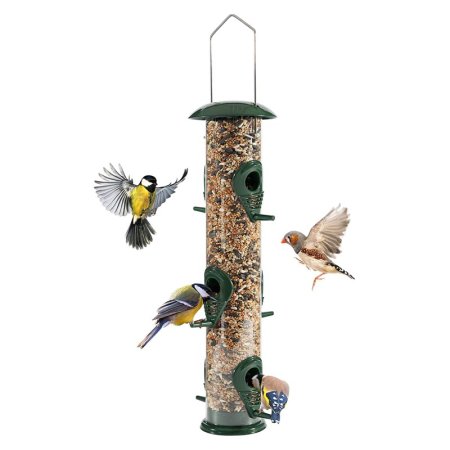
Pros
Cons
Product Specs
- Type: Tube
- Capacity: 4 cups (about 1.5 to 2 pounds)
- Squirrel-proof: No
The green color of this tube feeder from Gray Bunny blends with the outdoor environment, and the metal construction of the lid, base, and perches prevents squirrels from chewing. Made of clear and thick polycarbonate plastic, the central tube is rigid and does not bend. It’s fully transparent and holds up to 4 cups of birdseed. When it’s time to clean the feeder and replenish the seed, the lid lifts up easily. With its metal hanger, the feeder can hang from a hook or tree branch.
Tube feeders are perfect for smaller bird species, and in testing we found that the Gray Bunny feeder easily attracted finches, chickadees, and nuthatches. While testing, larger birds did not land on or feed from the feeder as much. The metal tube feeder is durable and easy to hang. With its simple design, it easily blends into the surroundings. Place it near a window or patio to enjoy hours of pleasurable bird-watching.
Get the Gray Bunny bird feeder on Amazon or a 2-pack at Walmart.
Best Platform Feeder
Nature's Way Cedar Platform Tray Bird Feeder
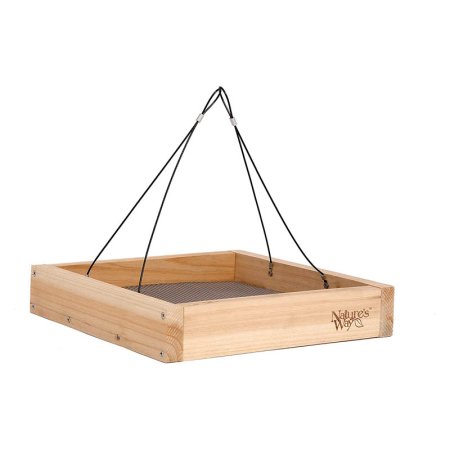
Pros
Cons
Product Specs
- Type: Platform
- Capacity: 2.8 pounds
- Squirrel-proof: No
Nature’s Way Cedar Platform feeder features an open design that gives birdwatchers an unobstructed view of their feathery friends. Made from natural weather-resistant cedar, this feeder attracts various birds, large and small, including ground feeders such as cardinals and doves. The feeder has a simple design—a 12 by 12 by 2.25-inch cedar tray suspended from two rubber-coated wires. It also features a mesh seed tray that lifts out of the feeder for easy cleaning.
We loved using this feeder in our backyard. It is truly a versatile feeder that attracts a variety of bird species. The feeder required no assembly but needed additional hardware to hang. We found that using a hanging planter-style hook that extends out at least 7 inches gave the feeder ample clearance. Also, this feeder is not squirrel-proof at all. In fact, it’s basically a free buffet for the tenacious creatures, and they will definitely pay a visit.
The feeder works best in a sheltered area, like a covered patio, to protect the seeds from rain. For those who don’t mind an occasional visit from a squirrel, it’s a nice feeder that will attract many birds.
Get the Nature’s Way bird feeder on Amazon, The Home Depot, or Tractor Supply Co.
Best Squirrel-Proof
Brome Squirrel Buster Standard Squirrel-proof Feeder
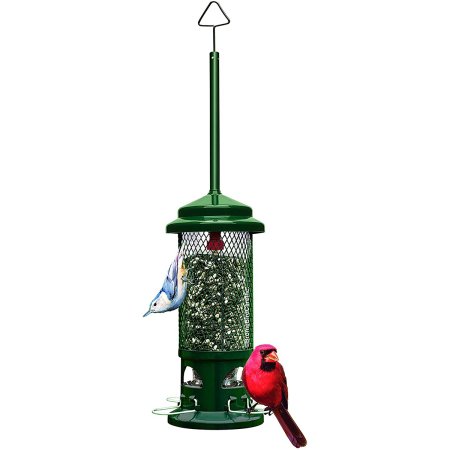
Pros
Cons
Product Specs
- Type: Hopper
- Capacity: 1.3 pounds
- Squirrel-proof: Yes
There seems to be an ongoing battle between bird lovers and squirrels when it comes to bird feeders. Thankfully, this bird feeder from Squirrel Buster features an innovative design to deter squirrels while keeping the seed available for the birds.
Hang this bird feeder from a hook or a tree branch with at least 18 inches of clearance to prevent the squirrels from reaching over to access the birdseed while maintaining a foothold on a nearby branch or pole. Forced to climb onto the feeder, squirrels soon learn that their weight triggers a closing mechanism, and they’re unable to access the birds’ food. Meanwhile, the lightweight birds enjoy feeding on the perches, since their weight does not trigger the closing mechanism. This squirrel-proof feeder also features chew-proof materials, including metal and RoxResinTM—a chew-proof, waterproof, and rustproof material.
We found that this feeder is durable, well constructed, and very squirrel-proof. It passed our testing with flying colors. We also liked that the feeder’s wire outer cage accommodates birds that prefer to cling, plus the feeder offers several feeding ports for birds that like to perch while feeding. The only con we had for this feeder is that it’s expensive. However, if squirrels are an issue, the Squirrel Buster is well worth the price.
Get the Brome Standard bird feeder on Amazon or Walmart.
Best Thistle Feeder
More Birds 38194 SeedFeed Stokes Select Finch Feeder
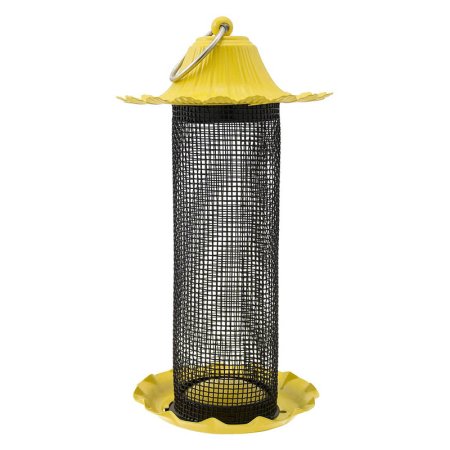
Pros
Cons
Product Specs
- Type: Hopper
- Capacity: 6 pounds
- Squirrel-proof: No
Thistle-loving birds love to have multiple feeding options. The More Birds feeder provides options for finches and other thistle eaters to feed in their most natural positions, whether clinging to the screen, perching on the seed tray, or even hanging upside down. The feeder is made from durable, high-density plastic to withstand outdoor elements.
The thistle feeder features an easy twist-off top and base for convenient filling and cleaning. It has built-in drainage holes that help keep seeds dry and a decorative flower-top design with a yellow powder-coated finish that brings a pop of cheery color to the landscape.
The finches in our yard loved this feeder. We particularly loved the yellow flower-style top for its whimsical beauty. Plus, when the goldfinches landed on the feeder, it just made the whole bird-feeding station look brighter.
Get the More Birds bird feeder on Amazon or Walmart.
Best Hopper Feeder
Perky-Pet 8lb Squirrel-Be-Gone II Feeder Home
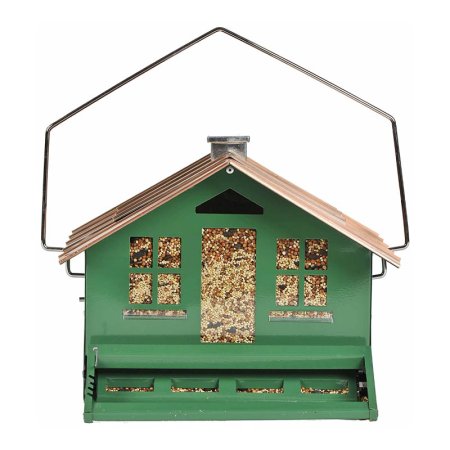
Pros
Cons
Product Specs
- Type: Hopper
- Capacity: 8 pounds
- Squirrel-proof: Yes
The Perky-Pet Squirrel-Be-Gone II Feeder Home features a gabled roof, a chimney, and a front porch perch, making this feeder look like a charming country home. It features strategically placed cutouts that look like windows and a front door so that you can monitor the seed level from afar. It’s made of durable metal and finished in a bold green or red color. The feeder holds up to 8 pounds of seeds and is squirrel-proof.
This adorable feeder is equipped with weight-activated perches. When an animal that is heavier than a bird, such as a squirrel, lands on the perch, it goes down and closes the feeding ports, blocking off the seed. The feeder can hang from a sturdy hook or mount on a pole.
The birds flocked to this feeder as we tested it in our yard. We loved the way this feeder looked and we appreciated its sturdy construction. The only con we noted for this feeder is that it is heavy when full of seed. Even when hung on a shepherd’s hook, the hook bowed due to the feeder’s weight. This feeder is best mounted on a pole.
Get the Perky-Pet bird feeder on Amazon or Ace Hardware.
Best Suet Feeder
Birds Choice SNTP Recycled Single Cake Suet Feeder
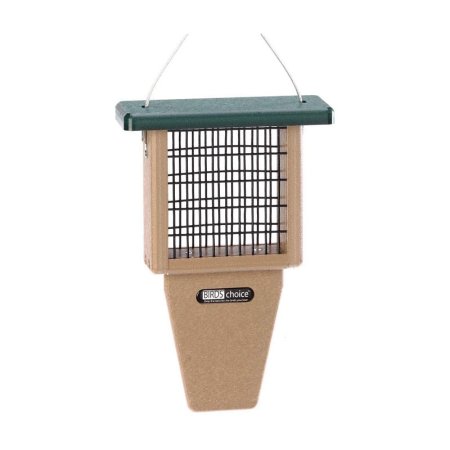
Pros
Cons
Product Specs
- Type: Suet
- Capacity: 1 cake
- Squirrel-proof: Yes
The Birds Choice SNTP Recycled Single Cake Tail Prop Suet Feeder is perfect for attracting a wide variety of birds. Birds such as nuthatches, woodpeckers, and jays love suet because it’s a high-energy food that’s especially valuable in cold weather. This single-cake suet feeder features an extra-long tail prop that helps keep the feeder balanced so larger birds, like pileated woodpeckers, can feed comfortably in a stable position.
The feeder holds one suet cake and is made from recycled, durable poly-lumber that withstands harsh weather without splitting or fading for years. It also includes aluminum rust-resistant hinges, stainless steel screws, and reinforced cable wire for secure hanging.
The suet eaters in our yard loved this feeder. It stayed perfectly balanced as large and small birds fed from it. It also looks good and feels very durable. The only con we had was the price, which is higher than most basic suet cages. However, due to its durable construction, we can tell this feeder will last for years.
Get the Birds Choice suet feeder on Amazon, Lowe’s, or Walmart.
Best Nectar Feeder
Aspects HummZinger HighView 12 Oz Hummingbird Feeder
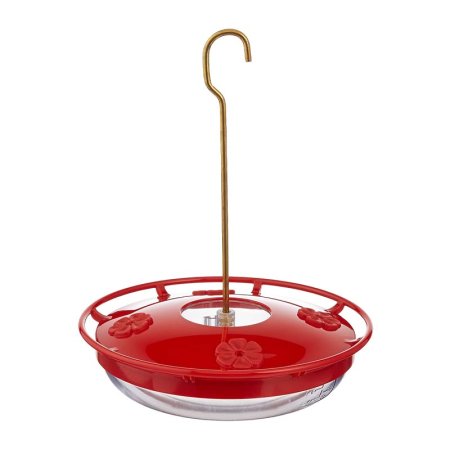
Pros
Cons
Product Specs
- Type: Nectar
- Capacity: 12 ounces
- Squirrel-proof: N/A
Aspects HummZinger Highview feeder is a dish-style hummingbird feeder made of unbreakable polycarbonate built to last for many seasons. This feeder resists temperature and weather extremes and is impact-resistant.
The bright red cover on the Aspects HummZinger Highview feeder attracts hummingbirds from a distance. Its reservoir holds 12 ounces of nectar and features four feeding ports that allow multiple birds to feed at once. This feeder has a built-in ant moat and bee-resistant design to protect the nectar from spoilage. The top removes easily for quick, thorough cleaning.
In testing, we found that this feeder is small enough to use in a balcony container garden or a large backyard bird habitat. We loved how easy it is to fill, clean, and hang. Its integrated perch allows the visiting hummingbirds to perch on the side with no issues. The Aspects HummZinger’s simple design and durable and lightweight construction make this our top nectar feeder pick.
Get the Aspects HummZinger nectar feeder on Amazon, Target, or Walmart.
Best Feeding Station
Best Choice Products 4-Hook Bird Feeding Station
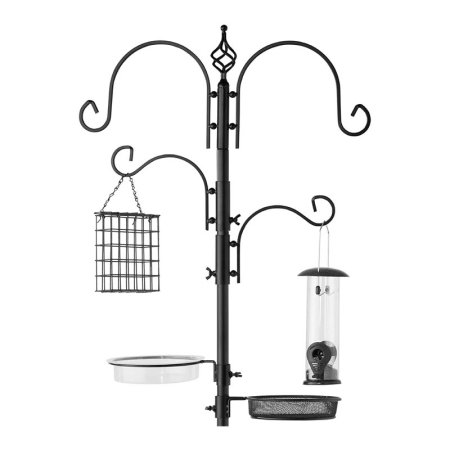
Pros
Cons
Product Specs
- Type: Multiple
- Capacity: N/A
- Squirrel-proof: No
The Best Choice Products 4-Hook Bird Feeding Station is an all-in-one kit that allows users to feed various birds. This unique product includes four hooks on which users can choose to place the included tube feeder and suet feeder. The two extra hooks hold additional feeders or garden decor. It also includes a water bowl/birdbath and a food tray.
The central support pole stands 80 inches above the ground and is made from coated, weather-resistant steel. It has a four-prong base that includes ground stakes that insert deep into the grass for stability. Some assembly is required.
Overall, we liked this feeding station and thought it was a good product for first-time birdwatchers. It was easy to put together, and the assembly instructions were simple to follow. However, the joints along the central support pole are not super stable. Even with the four-prong base, the entire feed station swayed. Nonetheless, we think the feeding station offers plenty of options and is an excellent way to get into bird watching without spending a ton of money.
Get the Best Choice Products bird-feeding station on Amazon or Target.
Our Verdict
We selected the Brome Squirrel Solution200 bird feeder as our top pick because it provides multiple feeding ports, offers long-lasting durability, and is squirrel-proof. In testing, it easily attracted birds, provided ample space for them to perch comfortably while feeding, and was easy to hang and maintain. The Perky-Pet Copper Panorama bird feeder is a cost-effective way to attract and feed birds. Its large capacity makes it a great choice for feeding birds of all sizes.
How We Tested the Best Bird Feeder
We tested each bird feeder according to established rubrics that included capacity, materials, extra features, ease of cleaning and filling, overall aesthetics, and how well it attracted various birds. We rated each feeder based on these rubrics on a scale between 0 and 4 to determine their score.
We first determined how easy it was to fill and clean the feeders. Next, we examined the feeder’s hanging mechanism and sturdiness. Lastly, we mounted each feeder and observed how well it attracted birds and how easy it was for the birds to feed. Lastly, we rated each feeder based on its aesthetics.
FAQs
Purchasing one bird feeder can be the prelude to a lifelong birding hobby as well as the beginning of a collection of clever and attractive structures for feeding and viewing birds. Before making a final selection, the following answers to frequently asked questions may provide additional insight into the optimal procedures for selecting and using bird feeders.
Q. Are plastic or metal bird feeders better?
In locations where squirrels might chew on the bird feeder, a metal material will hold up better than plastic. Alternatively, a sturdy polycarbonate plastic is rustproof, unlike many metal materials.
Q. Where is the best place to put a bird feeder?
Place a bird feeder near water and sheltering plants, and away from predators, such as cats. Avoid noisy and busy locations or spots where squirrels can easily jump onto the bird feeder.
Q. How often should I clean my bird feeder?
Empty the bird feeder every 2 weeks. Wash with mild soap and water, and let it air dry. Then, refill with fresh seed.
Q. Which bird feeder attracts most birds?
Hopper-style bird feeders attract many species of birds, since fresh seed is kept dry in the hopper and descends into the feeding tray on demand.
Q. How can I deter squirrels from my bird feeder?
A cone-shaped baffle attached to a pole can deter squirrels from climbing up to a bird feeder. Alternatively, hanging bird feeders specially designed to close off access under the weight of a squirrel provide a deterrent to those unwelcome guests.
Q. Can bird feeders attract rats, mice, and other pests?
Yes. Rodents and other pests may be attracted to the seeds and shells that the birds drop from the feeder. Use a seed-catching tray, clean up regularly, and install baffles to discourage unwelcome critters from accessing the bird feeder.
